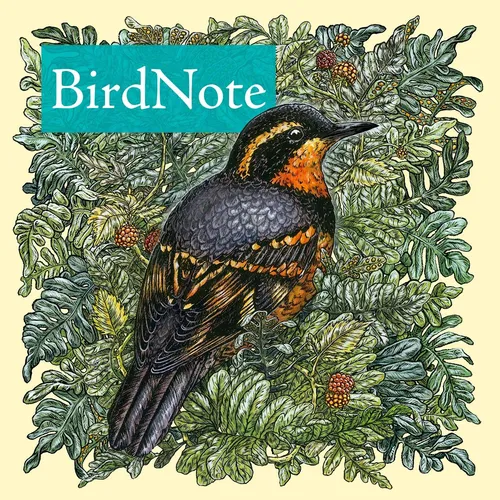
BirdNote Daily
Escape the daily grind and immerse yourself in the natural world. Rich in imagery, sound, and information, BirdNote inspires you to notice the world around you.
- Update frequency
- every day
- Average duration
- 1 minutes
- Episodes
- 1166
- Years Active
- 2022 - 2025

Henry David Thoreau and the Wood Thrush
In June 1853, Thoreau wrote of an enchanting encounter with the Wood Thrush: "This is the only bird whose note affects me like music. It lifts and exhilarates me. It is inspiring. It changes all hour…

Raptors in the Mojave Desert
Desert raptors get most of their water from eating prey animals. Biologist Blair Wolf explains, “if you think of any insect or a mouse or something like that, they’re maybe 75% water.” Those animals …

Sitting in the Catbird Seat
Longtime baseball announcer Red Barber often described a player in a winning situation as "sitting in the catbird seat." So what is "sitting in the catbird seat"? And what is a catbird? The Gray Catb…

Spark Bird: Ryan Mandelbaum and the Great Blue Heron
As a kid, science writer Ryan Mandelbaum avoided birds, thinking they were gross and kind of scary. But doing a video project in journalism school, Ryan had to search all over to get footage of a Gre…

Starlings and Roman Divination
European Starlings were present in great numbers in ancient Rome. They swarmed in massive flocks or murmurations — thousands of individuals cascading and folding in awe-inspiring geometric patterns i…

Remembering Martha: The Last Passenger Pigeon
In the early 1800s, the Passenger Pigeon was one of the most abundant bird species in North America — possibly the world. But by 1910, the last surviving representative of the species was a bird call…

Highways as Habitat for Hawks
In 1956, the Eisenhower Administration announced plans for the nation’s new interstate highway system. Planners foresaw 41,000 miles of superior highways, with a grassy border on either side and down…

Fruit as a Bribe
In summer, many shrubs bear fruit that birds find irresistible. Elderberries, serviceberries, blackberries, dogwood berries, mulberries, and currants attract many species of birds, including waxwings…

What Do Desert Birds Drink?
In the desert Southwest, water can be scarce. Yet some birds, like this Black-throated Sparrow, thrive in a scorching landscape. The birds obtain moisture from foods like nectar and fruit, as well as…

How High Do Birds Fly?
For the majority of the year, most birds stay under 500 feet. During migration, many species fly at 2,000 to 5,000 feet or above, using prevailing winds to assist them. And some birds go even higher!…

Letter to an Eastern Wood-Pewee
In this episode, ornithologist J. Drew Lanham reads a letter he has written to a wood-pewee, a flycatcher with an “understatedly simple and definitive” song that says the bird’s name.
More info and tr…

Long-billed Curlews Whistle from the Sky
Long-billed Curlews are the largest shorebirds in North America. In his courtship display, the male Long-billed Curlew flies a series of arcs across the sky, calling as he goes. Outside of the breedi…

Slowing Down and Observing Female Birds
The colorful feathers and loud songs of male songbirds often catch a birder’s attention first. Observing females often means birding more slowly, noticing subtle differences in plumage and behavior, …

David Sibley – Sketching and Painting Impressions
David Sibley’s paintings connect millions of people with the lives of birds. His talent in observing and portraying birds culminated in The Sibley Guide to Birds. Sibley describes how he learned to s…

Birds That Say Their Own Names
Some birds, such as the Northern Bobwhite, get their name from their songs or vocalizations: "Bobwhite! Bobwhite!" The Killdeer is another bird named for its song: "Kill-dee, kill-dee, kill-dee." The…

Quirky Words for Brown Birds
What do Fulvous Whistling-Ducks, Bay-breasted Warblers, Ferruginous Hawks, and Rufous Hummingbirds have in common? They are all birds whose names refer to a shade of brown!
More info and transcript at…

How Birds Stay Cool
On a hot summer’s day, watch a bird such as a crow — or this Bald Eagle — very carefully. You’ll never see them sweat, because birds don’t have sweat glands. So how do they keep cool? One way is pant…

The Royal Ravens
The Tower of London has a long and notorious history of murderous political intrigue, dungeons, and famous beheadings. And for more than 300 years, the tower has also been home to a set of royally ma…

How Brown Pelicans Dive
Brown Pelicans fly just above the surface of the water. They circle high, then diving headfirst, plunge under water to catch fish. But doesn't that hurt? Several adaptations protect pelicans as they …

Quail and Their Fancy Feathers
Gambel’s Quail and California Quail are both well known for the comma-shaped tuft of inky black feathers poised atop the crown of their heads. For both species, this decorative “topknot” is formed fr…